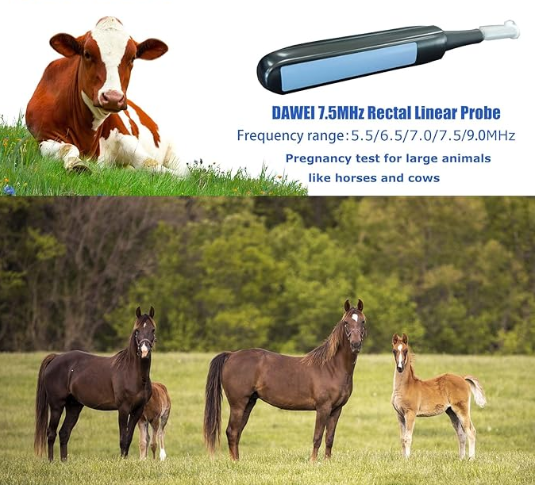Cattle farms do a lot of pregnancy testing every year, and there are many methods available rectal palpation, cattle ultrasound machines for pregnancy testing, blood tests, etc., now here are the pros and cons of these methods:
Rectal palpation to detect cow pregnancy This is our old, stable standby. Skilled palpators can palpate the structures involved pregnancy is shortened to about 35 to 40 days after breeding. In determining the animal’s gestation status, the palpator evaluates the amniotic sac surrounding the fetus, the fetus itself, and the cotyledons, which are the fetus’s connecting dam to the uterus. Evaluation of the dimensions of each of these structures provides an estimate of the stage of gestation. This method has served us well for countless years and provides more information than “pregnant” or “empty”. Palpation also provides an opportunity to determine if there are any abnormalities in pregnant or empty cows. This may be especially valuable in cows that are empty. Is there something wrong with her that is causing her to be empty? The results of palpation are immediate and can be used to immediately categorize open cows coming out of the herd. Are there any potential negative effects of palpation? In dairy cows, there have been concerns over time that direct palpation may harm the fetus. The study conducted by Texas A&M University compared two large herds of cows that were confirmed pregnant by ultrasound 29 to 32 days after breeding. The cows were then palpated at 34 years of age and 41 days of pregnancy using a “membrane slip” technique – a technique that was thought to cause problems – or not palpated. There was no difference in fetal survival between cows that were palpated and those that were not. Additional research supports this finding.
Bovine ultrasound machines are gaining popularity on breeding beef farms because they can be used for early pregnancy detection and determination of fetal males and females. Bovine ultrasound machines can be used for early pregnancy testing at about 26 days after breeding, while the need for male/female determination occurs at 60-90 days. Some people use fetal males and females of heifers as a basis for classifying pregnant heifers based on risk, and heifers carrying bull calves may be more likely to have difficulty with larger calf sizes. In large herds, this allows for use to enhance monitoring of a small group of heifers.

As with palpation, examination for reproductive tract problems can be detected at that time. Ultrasound can also detect fetal heartbeats to confirm viability. Ultrasound can be performed at approximately the same rate as palpation and neopalpation.” Armless” ultrasound devices minimize wear and tear on the palpator by placing the probe at the end of an inserted extension arm, eliminating the need for a manually operated probe. Ultrasound is usually performed with a slightly higher per capita related palpation charge.
Blood testing for bovine pregnancy is newer than palpation and ultrasound, having only been around for about 10 years. **Recent marketing efforts have brought it to the forefront of discussion over the past two to three years. Available tests detect pregnancy-specific protein B (PSPB) and pregnancy-associated glycoproteins, which are present in the blood of pregnant cows at 28 days after breeding. Although various studies have shown these tests to be accurate (using ultrasound as the gold standard test), two major problems have occurred: pregnant cows are said to be too low to be detected because of their PBSP levels, and empty cows are said to be pregnant because the hormone is retained in the blood for a long period of time after abortion. Blood is used as a target for early pregnancy detection. However, in contrast, blood testing does have one major disadvantage over palpation or ultrasound: delayed results. For most calving herds, it is inconvenient to run cows through a chute to obtain samples and then have to hold them for sorting to obtain results later. With palpation or ultrasound, cows can leave the chute and go to pasture or sale immediately. The extra time spent sorting the cows after receiving the results eliminates any perceived cost and saves money over palpation or ultrasound.
With all of these pregnancy diagnostic options, it is possible to perform goals that fit the needs and meet the goals of virtually any herd. There are considerations when using them Discuss your herd goals with your veterinarian to determine this It is important which test or combination of tests should be used to determine pregnancy status your cattle.
Post time: Mar-07-2024



